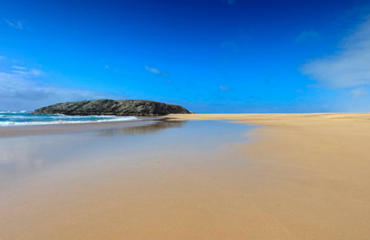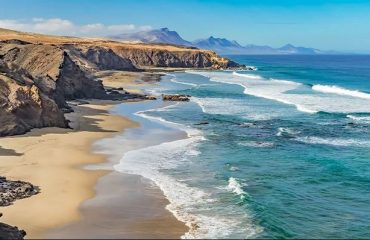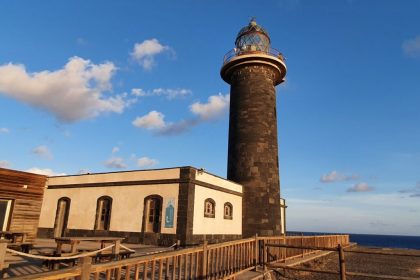
Fuerteventura is known for its impressive and paradisiacal beaches, for its dunes or for its picturesque towns. But we can also visit it through its lighthouses, another of its great attractions. Fascinating viewpoints, some of which have now become interesting museums, the lighthouses and their sparkles hide innumerable stories of sailors and navigators from ancient times. Today we visit, from north to south, some of the best known on the island. From Punta de Jandía to the neighboring Islote de Lobos, the island of the wind not only boasts paradisiacal beaches, perfect waves and unique sea beds, the lighthouses are another of its great attractions. From half paved roads to roads with infinite curves, the lighthouses of Fuerteventura are worth visiting to savor the privileged environment where they are located.
1. FARO DE MORRO JABLE
The simplicity of the tower, very slender and painted entirely in white, gives the lighthouse that characteristic appearance that has made it a benchmark for a landmark lamp, clearly visible in the distance thanks to its great height. It does not have an attached service pavilion and to go up from the base to the lantern, which is 62 meters above the ground, you have to do it through an elevator or a spiral staircase attached to the interior walls of the tower. The Morro Jable lighthouse rises in the natural area of the Matorral beach, it is a protected natural space of scientific interest due to its very peculiar coastal ecosystem

2. FARO DE PUNTA JANDIA
At the southernmost point of the island of Fuerteventura, within the Jandía Natural Park, is the Punta de Jandía lighthouse, whose slender figure has helped sailors for many years. Built in the mid-19th century, it contains an exhibition inside, on the seabed of the area and the cetaceans that inhabit it: beaked whales, sperm whales and pilot whales. Its mission was to guide the ships that were heading from Europe to the ports of Spanish and French West Africa, as well as the ships that made the route from the port of Las Palmas to Gran Tarajal and Puerto de Cabras.
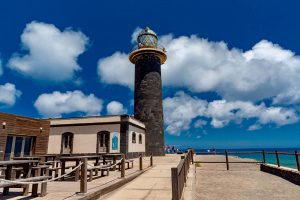
3. FARO DE PESEBRE
We found it in Punta Pesebre, very close to the Punta Jandía lighthouse. He got up to guide the ships that approached from the northern part of Punta de Jandía. Its appearance is very simple, with a gate and a beacon. It’s not really a lighthouse, but we wanted to add it, since their functions are similar. It is considered one of the smallest in Europe.
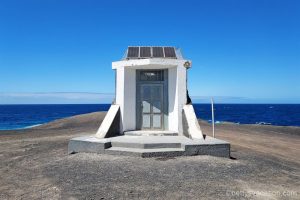
4. FARO DE ENTALLADA
The Entallada Lighthouse is characteristic for its red stone ashlars from the Bermeja Mountain, in Tefía. It was built in 1953 by the engineer of roads, canals and ports. It offers spectacular views of the sea 200 meters high, from the viewpoint that culminates a wooden access on the cliff. Inland, the landscape is equally attractive: the Cuchillos de Vigán Natural Monument, its environment representative of recent volcanism, and it is common to observe endemic birds such as guirres, ravens, and birds of prey such as the barbary falcon.
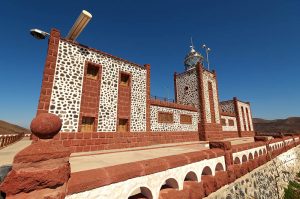
5. FARO PUNTA GAVIOTO
The Puerto del Rosario lighthouse is located between Punta del Gavioto and Punta La Arena. This circular tower, 43 meters high and white in color, was built, according to the plaque, in 1992, although the initial date of construction is at the end of September 1991. Its austere architectural style is only accompanied by of a small room, a couple of meters from the base of the tower, denotes its functional construction.
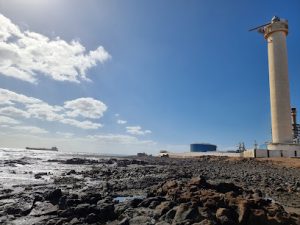
6. FARO PUNTA MARTIÑO
The Punta Martiño lighthouse is located on the homonymous mountain at the northeast end of the islet of Lobos, just 5 km from Puertito. The Martiño Lighthouse, together with the Tostón Lighthouses, in El Cotillo, and the Pechiguera Lighthouse, in Lanzarote, form a triangle to mark the passage of ships through the Bocaina Strait, which separates the islands of Lanzarote and Fuerteventura. The Punta Martiño Lighthouse is a small lighthouse, with a height of 12 meters and a white tower with a lantern that rises 29 meters above sea level. It was built in 1865 and renovated in 1903.

7. FARO DEL TOSTON
In the extreme northwest of Fuerteventura, the Tostón Lighthouse completes the triangle that signals navigation in the Bocaina Strait, next to the Pechiguera (Lanzarote) and Martiño (Islote de Lobos) lighthouses. It is a must-see enclave to the north of El Cotillo, because around it are the famous lagoons with crystalline waters protected by reefs, ideal for enjoying safe bathing with the family, and spectacular sunsets as the sun sets. over the sea. The Tostón Lighthouse reflects the evolution of maritime signaling like no other, by preserving the structures of the three lighthouses that were successively enabled, the first next to the main building in 1897, a second tower, 13 meters high, in 1955, and the most modern tower, 37 meters high, which began operating in 1986.
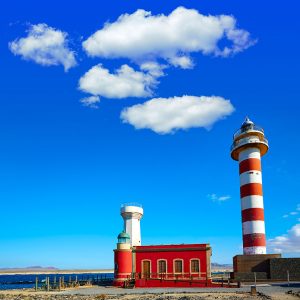

 Español
Español  Deutsch
Deutsch  Français
Français  Italiano
Italiano 
